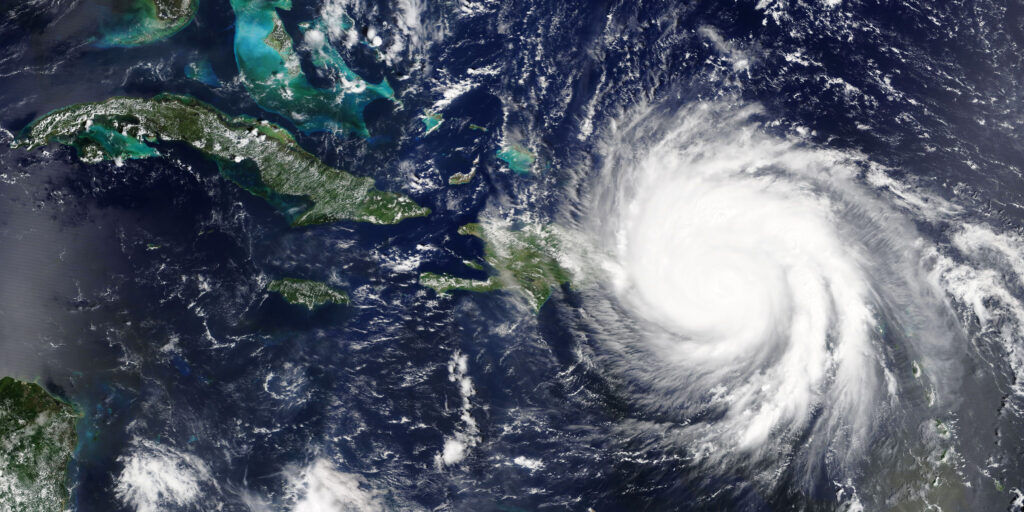Advances in satellites, networking technology increase the options for disaster response planning
Of all the natural disasters that plague mankind, hurricanes are perhaps among the most predictable. Satellites, aircraft observations, weather balloons and ocean buoys, coupled with sophisticated forecasting models, enable scientists to begin tracking tropical storms almost the moment they form. The path of a storm is tracked continuously across oceans and its probable points of landfall are predicted days in advance.
Yet for all the advance warning, local and state governments face daunting challenges in managing the disaster response. Perhaps most important in delivering aid to those in need are reliable communications networks that link first responders from a wide range of agencies to one another, allowing the dispatching of emergency workers and the coordination of the many services required. As assuredly as hurricane season comes around every year, storms will cause power outages, disabled cell towers and inoperable telephone networks, making emergency communications all but impossible right when they are needed the most.
What’s more, paying for disaster response grows more costly every year, as changes in weather patterns create more frequent and stronger hurricanes, tornadoes, wildfires and flooding. Data compiled by the National Oceanic and Atmospheric Administration (NOAA) found that from 1980 to 2022, the U.S. had an average of eight weather/climate disaster events per year with losses exceeding $1 billion. Through the end of May, there have already been seven such events this year. The annual average for the past five years has been 18 such events.
The increased frequency and severity of these disasters has made it far more difficult—and expensive—for local and state governments to prepare and respond. This makes it more important to line up as many resources as possible in advance of a disastrous weather event, and to work with equipment and satellite bandwidth vendors to know what new resources might have become available since the last time an agency prepared its disaster plan.
In fact, several new technologies are emerging that may help reduce the cost of temporarily replacing communications networks with substitute equipment to lighten the burden on first responders today and into the future. These include Low Earth Orbit (LEO) satellite constellations, mobile antenna technologies, standalone 5G systems and more.
New satellite service options
One of the biggest changes is the availability of new satellite services. Satellites in geosynchronous orbit (GEO) are 22,000 miles from the Earth, far away from the downed power lines and damaged cell towers left in a hurricane’s wake. With decades of tried-and-true performance after hurricanes, GEO satellites remain a dependable and affordable option for emergency connectivity.
Today, new LEO systems are coming online to offer another option for satellite connectivity in the aftermath of a hurricane. These satellites also orbit safely above the damage zone of a natural disaster on the ground. However, as their name suggest, LEO satellites, like the ones launched by OneWeb, operate only about 600 to 1,000 miles from Earth, resulting in a lower latency option (when compared to the GEO satellites), which can be advantageous for certain applications.
As with any type of connectivity, speed, latency, price and availability will vary and should all factor into the choice of GEO or LEO system or, in some cases, a combination of both for an extra layer of resiliency for mission-critical communications.
New antenna technologies
One tried and true tactic for post-disaster connectivity is to pre-stage communications equipment near the potential disaster zone, as FEMA and several state emergency management agencies often do. The Very Small Aperture Terminal (VSAT) used for GEO connectivity is a cost-effective procurement for this purpose. However, the VSAT requires a certain amount of training or expertise to point and align correctly for optimal GEO service.
Here again is a new technology that’s just entering the market and makes a great option: the electronically steerable, flat panel antenna used for LEO connectivity. The new Hughes LEO Terminal includes the indoor modem and new antenna, which measures about the size of a briefcase and self-aligns to the OneWeb satellite constellation so long as it has a clear view of the sky. The antenna can connect to the OneWeb constellation in seconds and support download speeds of up to 195 Mbps with low latency, thus providing a new option for enhanced emergency communications.
Direct-to-device services
Connecting conventional cell phones to satellites is another innovation with real promise for emergency communications. Perhaps most widely known, Apple has equipped the iPhone 14 (released in 2022) with a chip that can send and receive basic messages via satellite when the phone is outside the reach of the mobile network. A company called Skylo in Europe offers a ruggedized phone from Bullitt that connects to satellite for similar direct-to-smartphone service. It’s easy to see the appeal of smartphone connectivity over satellite for post-hurricane communications—and out of network mobile connectivity for non-emergency communications, too.
While NOAA predicts a “near normal” outlook for the 2023 hurricane season, the options available to state and local governments to plan their disaster response are evolving and improving quickly. From time-tested GEO satellites to new LEO services and technologies, the communications industry is helping to reduce the barriers first responders face during natural disasters. It is vital that government agencies planning their response stay fully informed of the availability of these new resources to customize their plan to fit their regions, their requirements and their budgets.
James Clevenger is a director at Hughes Network Systems and has been in the telecommunications industry for more than 20 years, the past 15 of which he has supported both state and federal agencies and their missions. At Hughes, Clevenger leads government sales.



















